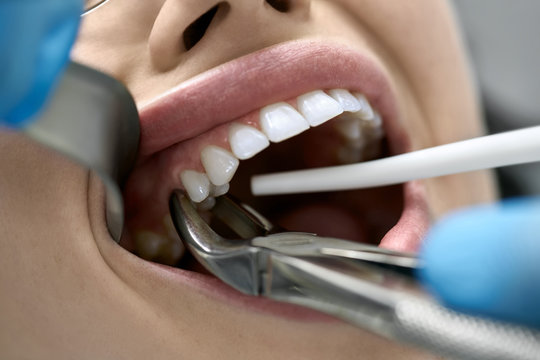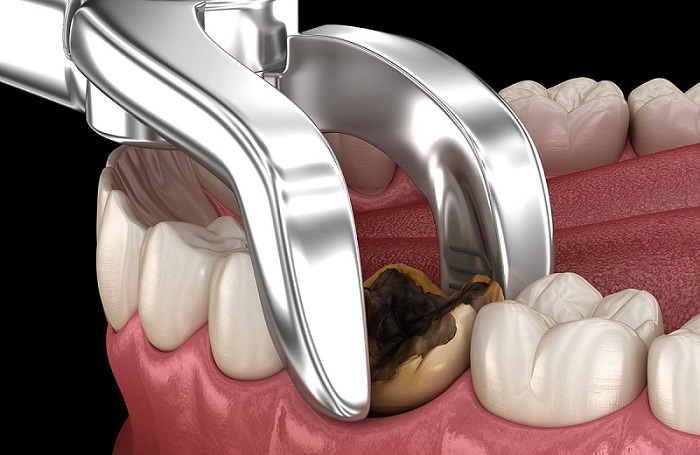What comes to your mind when you hear the term “tooth extraction?” I guess you would first freak out, placing your hands on your cheeks and clenching your teeth and, maybe, saying out loud “it’s going to be damn painful!” Fortunately, it’s not what you imagine/imagined at all. Let’s dive deeper into what tooth extraction is.
What Is Tooth Extraction?
Tooth extraction, also referred to as dental extraction, is the removal of tooth/teeth from the dental alveolus, which is the socket in alveolar bone. Simply put, tooth extraction is the removal of tooth from its socket in the bone. There are various reasons why dental/tooth extractions are carried out. Most teeth are extracted because they cannot be restored. This is because they have been damaged through tooth decay, periodontal disease, or dental trauma. The aforementioned dental diseases are, most a time, associated with toothache, which leaves the patient totally uncomfortable and frustrated. In some cases, impacted wisdom teeth can lead to repeated infections of the gum, and this may eventually lead to the removal of the tooth/teeth when other conservative treatments fail to work.
Like stated initially, tooth extraction is not a death sentence, neither will your face disappear from your body; it’s not as painful as you imagine it to be.
Tooth Extraction Procedures.
There are procedures to follow before tooth extraction commences. It’s important to know that extractions could be classified or pigeonholed into two (2), that is, non-surgical extraction and surgical extraction. Note that non-surgical extraction is simple, while surgical extraction could be a bit demanding. Truth is, whichever category one falls in actually depends on the type of tooth to be removed, and other factors involved. Let’s quickly run through the procedures of tooth extraction:
- Assessment of Tooth: first thing first, an in-depth investigation must be carried out in order to know the root cause of the tooth pain. More so, assessment of the tooth should be done clinically by the dentist.
- Consent from Patient: before going ahead to begin the process of tooth extraction, it is ideal that the dentist explains what is involved to the patient. The dentist should tell the patient other available treatment options (if there’s any), what is involved in the tooth extraction procedure, what the risks are, as well as what the benefits are. This way, the patient will know exactly what he/she is signing in for.
- Giving of Local Anesthetic: you don’t need to panic about experiencing pain during tooth extraction. This is because the dentist will apply local anesthetic to make sure that the tooth and surrounding tissues are numb before the extraction process.

Types Of Tooth Extractions
As earlier mentioned, extractions are classified or pigeonholed into two (2) types. They are:
- Simple extractions: these types of extractions are carried out on tooth/teeth that are visible in the mouth. It’s common for a general dentist to perform simple extractions because they not always complicated. What makes this process simple and easy is the fact that the patient will be under local anesthetic, and will need only the use of instruments to lift the visible portion of the tooth. Typically, the dentist will have to numb the tooth and the gum tissues, thereby loosening the tooth with the instrument referred to as an elevator before going ahead to remove the tooth with what is called dental forceps.
- Surgical extractions: this is a complex procedure that involves the removal of tooth that is difficult to access and be removed through simple extraction. This difficulty could be because the teeth have broken under the gum or haven’t come out fully, as in the case of impacted wisdom tooth/teeth. Surgical extractions, as a matter of fact, most often, require an incision-a surgical cut. Oral surgeons are expertise in handling surgical extractions. Notwithstanding, general dentists also carry out the operation. In this classification of extractions, the dentist will lift the soft tissues covering the tooth and bone, thereby removing some of the surrounding jaw bone with the help of a drill. While carrying out the surgery, most often, the tooth may be broken into fragments to enable its removal.
Common Risks After Tooth Extractions
There are common risks that always accompany tooth extractions. Some of these risks include:
- Pain.
- Swelling.
- Infection.
- Bruising.
- Bleeding.
- Trismus.
- Dry socket.
- Permanent or temporary damage to the inferior alveolar nerve.
- Permanent or temporary numbness.
- Tingling sensation to the lip and chin.
Necessary Things to Do After a Tooth Extraction
There are some basic and necessary things you need to do after a tooth extraction. These tips will help to remove and reduce the risk of infection and discomfort:
- For, at least, 24hrs, patients should rest and also avoid getting involved in anything stressful, for at least two (2) days.
- Take the pain killer prescribed by the dentist. These will help ease the pain and reduce the risk of getting infected.
- As soon as possible, apply a cold compress against the area where extraction took place. Doing this will prevent the affected side from swelling.
- Be sure to firmly bite the gauze so as to stop bleeding.
- Carefully spit and rinse your mouth. Any forceful activity will eventually lead to the dislodging of the blood clot.
- Patients should as much as possible avoid drinking from a straw for at least a day(24hrs).
- Desist from smoking so as to heal speedily. Just so you know, smoking is a harmful habit that can actually delay your recovery.
- Endeavour to eat soft foods only during your recovery period; don’t bite on anything hard as this can delay your healing.
- Patients should not forget to always prop their heads with pillow.
- Patients should not forget that proper oral hygiene is key; brushing and flossing as required. This is paramount in the recovery process.
Is Tooth Extractions Necessary?
It is highly advisable to try as possibly as you can to protect your teeth from any form of damage. This is the reason you should practice proper oral hygiene. If for any reason you have a damaged tooth that is beyond repair, you will have to consider tooth extraction. See your dentist who will recommend the best treatment that suits you.
Reasons For Tooth Extractions
There are a handful of reasons that necessitate tooth/dental extractions. Some of these reasons include the following:
- When decay or infection has eaten deep into the tooth/teeth.
- When there’s trauma or injury.
- When babies’ teeth take a long time to fall out, restricting the permanent teeth to come out.
- Another reason for tooth extraction is when there is no enough room for all the teeth in the mouth.
- Tooth extraction may be necessary during orthodontic treatment.
Don’t forge to visit your dentist every six months to have your teeth checked!







Leave A Comment